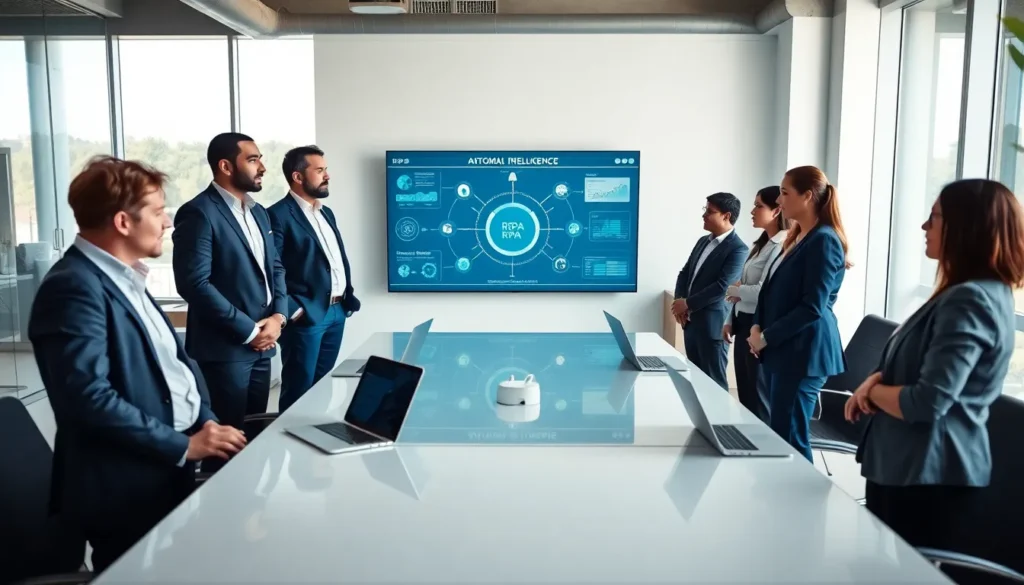Imagine a world where tasks that once took hours or even days are completed in mere minutes, all thanks to the magic of automation. Robotic Process Automation (RPA) is reshaping this landscape, but how does it mesh with other emerging technologies? Spoiler alert: it’s like finding the perfect dance partner at a tech gala. In this text, we’ll explore where RPA fits among its technological peers, including AI, machine learning, IoT, and even blockchain, giving you a clear overview of its pivotal role in today’s digital frontiers.
Brace yourself for an insightful journey as we connect the dots between RPA and other tech trends, proving once and for all that automation isn’t just a fad: it’s the future. Let’s immerse.
Table of Contents
ToggleUnderstanding RPA: A Brief Overview

Robotic Process Automation, or RPA, is fundamentally about streamlining repetitive tasks using software robots or ‘bots.’ These bots can mimic human actions when interacting with digital systems. From processing transactions to responding to queries, RPA can handle mundane tasks efficiently and accurately. This not only enables businesses to reduce operational costs but also frees up human employees to tackle more strategic initiatives.
Imagine a world where data entry is as outdated as floppy disks. RPA makes this possible by automating workflows that traditionally required extensive human involvement. It doesn’t replace jobs: instead, it reshapes them, enabling workers to focus on higher-value activities while bots take care of the grunt work.
The Intersection of RPA and AI
Now, let’s consider artificial intelligence (AI). While RPA excels at automating structured tasks, AI is able to process unstructured data and make intelligent decisions. When these two technologies converge, the possibilities are endless.
Consider a customer service scenario. RPA can handle routine queries through chatbots, while AI can analyze customer sentiment and provide tailored responses. In this way, RPA and AI complement each other beautifully. Together, they create a robust solution that not only enhances efficiency but also improves customer experience.
For businesses, this integrated approach allows for predictive analytics and smarter decision-making. As RPA implements tasks faster, AI ensures these tasks are performed with increasing levels of intelligence.
RPA and Machine Learning: A Synergistic Pairing
Machine learning (ML) is another exciting frontier where RPA finds its footing. Think of machine learning as the brain of a robot that continually learns from data. By integrating ML with RPA, organizations can automate certain processes that not only learn from past events but also adapt to new information.
For example, in fraud detection, RPA can collect and process transaction data, while ML algorithms analyze patterns and flag anomalies. This dual approach makes the system smarter over time, protecting organizations from fraudulent activities without constant manual oversight. By combining RPA’s automation capability with ML’s intuitive insights, businesses are able to enhance their operational agility and accuracy.
RPA and IoT: Enhancing Data Interaction
Let’s not stop there. The Internet of Things (IoT) is revolutionizing how we gather and process data from connected devices. RPA can play a crucial role in this ecosystem by automating the actions taken based on data collected from IoT devices.
For instance, consider a manufacturing plant where IoT sensors monitor equipment health. RPA can automatically generate maintenance requests when certain parameters are met, adapting workflows based on real-time data. This integration ensures that firms not only improve efficiency but also maintain equipment proactively, reducing downtime and costs.
Harnessing the power of both RPA and IoT enhances overall operational efficiency, representing a significant leap in how businesses interact with their environments.
Integrating RPA with Blockchain Technology
Blockchain technology is often regarded as confusing tech jargon, but its potential applications are undeniable. RPA can integrate seamlessly with blockchain to improve transparency and trust. Data processed through RPA can be logged onto a blockchain, providing an immutable record of transactions and processes.
In finance, for instance, RPA can automate the reconciliation of accounts, while blockchain maintains secure records of all transactions. This synergy not only reduces the chances of fraud but also enhances compliance with regulations, ensuring that organizations can operate with greater confidence.
So, when RPA meets blockchain, the results are transformative, creating a trustworthy digital ecosystem.
The Future of RPA in the Tech Ecosystem
As new technologies continue to emerge, the landscape of possibilities for RPA expands. From improved cloud capabilities to advancements in quantum computing, RPA is set to become even more powerful. Organizations are increasingly recognizing the need to integrate RPA across their operations, leading to a more interconnected tech landscape.
Besides, as industries evolve, the demand for smarter automation solutions grows. Future iterations of RPA will likely incorporate advanced capabilities, such as real-time analytics and more adaptive automation processes. This evolution will redefine how businesses operate, allowing them to respond swiftly to market changes and customer needs.









